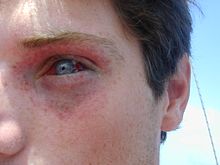Diving disorders
General environmental conditions can lead to another group of disorders, which include hypothermia and motion sickness, injuries by marine and aquatic organisms, contaminated waters, man-made hazards, and ergonomic problems with equipment.
A special case, where pressure in tissue is reduced to the level that causes dissolved gas to come out of solution as bubbles, is called decompression sickness, the bends, or caisson disease.
Nevertheless, barotrauma occurs and can be life-threatening, and procedures for first aid and further treatment are an important part of diving medicine.
Severe cases can result in cell damage and death, with effects most often seen in the central nervous system, lungs and eyes.
Variations in arterial oxygen concentrations can be part of the normal physiology, for example, during strenuous physical exercise.
This condition may lead to a loss of consciousness underwater and consequent death either directly by cerebral hypoxia, or indirectly by drowning.
Carbon monoxide is a toxic gas, but, being colorless, odorless, tasteless, and initially non-irritating, it is very difficult for people to detect.
Diving medical personnel need to be able to recognize and treat accidents from large and small predators and poisonous creatures, appropriately diagnose and treat marine infections and illnesses from pollution as well as diverse maladies such as sea sickness, traveler's diarrhea and malaria.
If exposed to cold and the internal mechanisms are unable to replenish the heat that is being lost, a drop in core temperature occurs.
Seasickness is a form of motion sickness, a condition in which a disagreement exists between visually perceived movement and the vestibular system's sense of movement[38] characterized by a feeling of nausea and, in extreme cases, vertigo, experienced after spending time on a craft on water,[39] floating at the surface of a rough sea, and in strong surge near the bottom.
Nonfatal drowning in marine environments brings seawater into the lungs where the water goes through our nose or through the mouth resulting in pneumonia.
In addition to mechanisms similar to those for natural hazards, injuries caused by impact with the dive boat or other vessels or their moving parts, like propellers and thrusters, and by tools and equipment is possible.
These are first aid oxygen administration at high concentration, which is seldom contraindicated, and generally recommended as a default option in diving accidents where there is any significant probability of hypoxia,[citation needed] and hyperbaric oxygen therapy (HBO), which is the definitive treatment for most incidences of decompression illness.
The administration of oxygen as a medical intervention is common in diving medicine, both for first aid and for longer-term treatment.
[48] Hyperbaric oxygen treatment is generally preferred when effective, as it is usually a more efficient and lower risk method of reducing symptoms of decompression illness, However, in some cases recompression to pressures where oxygen toxicity is unacceptable may be required to eliminate the bubbles in the tissues that cause the symptoms.
[6][54] There is a definite relationship between length of time exposed to extreme depths and the percentage of divers with bone lesions.
The combined influence of diving-related factors on free radical production and the long-term effects on diver resilience and health are not yet understood.
[56] Cumulative exposure to high partial pressure of oxygen is known to accelerate the development of cataracts, a visual disorder that affects most people who live long enough.
The mortality rate in recreational diving is very low, and the risk of accidental drowning is unlikely to have a significant influence on the average life expectancy of divers.



